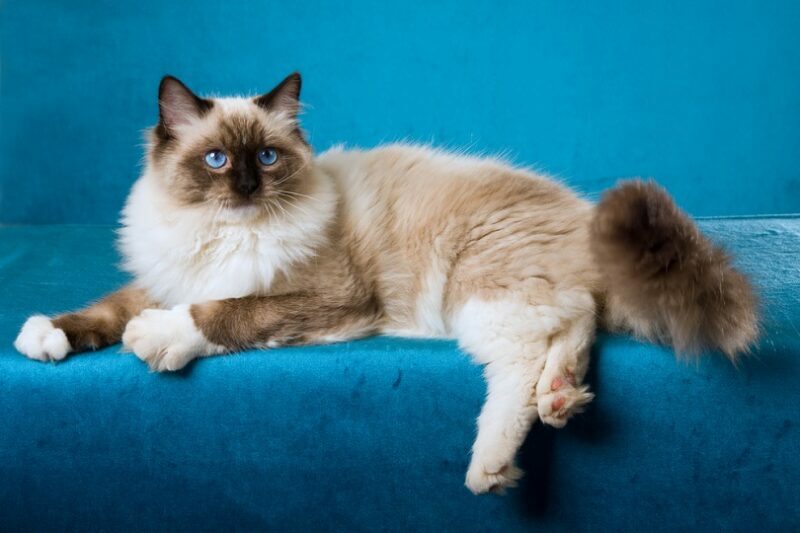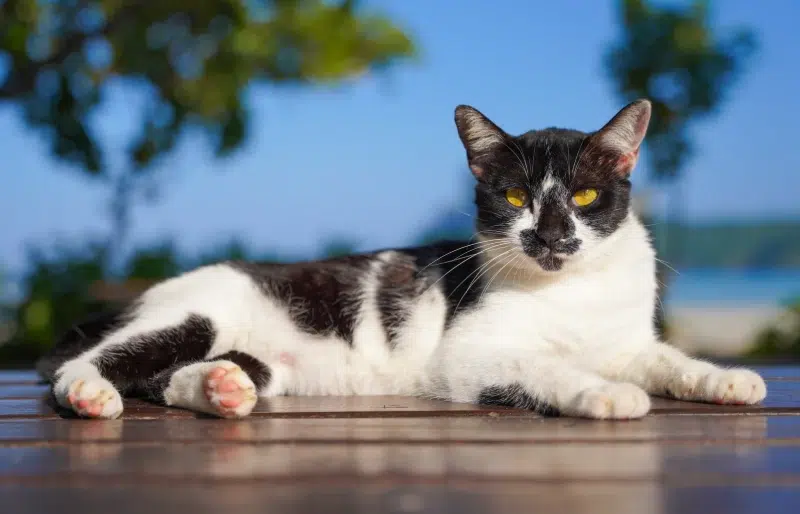Click to Skip Ahead
A Ragdoll is a larger breed of cat that is well-known for its tendency to flop when you pick them up. They come in a few different colorations, including seal point. All of the colorations have the same personality and overall appearance.
Breed Overview
Height:
10-13 inches
Weight:
8-20 pounds
Lifespan:
10-15 years
Colors:
Seal, chocolate, blue, and lilac, with three pattern variations
Suitable for:
Just about any family, single or couple who loves cats
Temperament:
Easy-going, affectionate, friendly, vocal
They are not separate breeds, though they are sometimes sold as such. Because of this, seal point ragdolls will act precisely like all other ragdolls. They are only a different color.
In this article, we’ll discuss everything you need to know about ragdolls.
Seal Point Ragdoll Characteristics
Seal Point Ragdoll Kittens
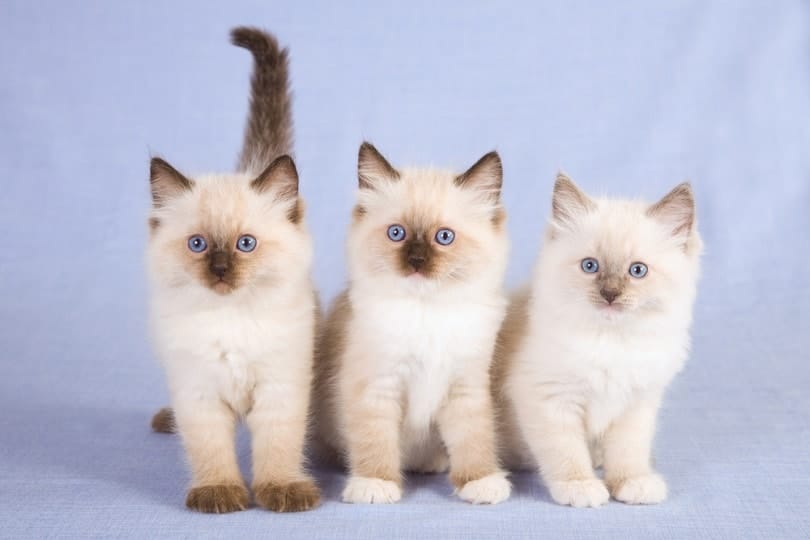
Ragdolls are rather large cats. Males are significantly larger than females and can weigh anywhere between 12 to 20 pounds. Females only weigh around 8 to 15 pounds. Often, there is a noticeable size difference between these two animals.
Their head is rather large for a cat, while their ears are about average. On top of being rather large, they are also very long, even when you consider their overall bigger size.
Ragdolls are a pointed breed. This means that they are light in color overall, with various points of darker color throughout their body. This is why many colorations, including the seal point, include the word “point.” The cat won’t be a solid color. Instead, it will have points of color around the ears, face, legs, and tail.
3 Little-Known Facts About Seal Point Ragdolls
1. They are not a separate breed.
Seal point Ragdolls are the same breed as your usual Ragdoll. However, they do have a special coloration that gives them a unique look.
2. You can’t always tell which cats are seal point.
Not all cats are apparent seal points from birth. Usually, colorations and markings change as the cat ages, so you may not actually know if you have a seal point cat until later.
3. Ragdolls are named Ragdoll for a reason.
Ragdolls are well-known for becoming floppy when held. This is how they got their name. All cats, no matter their coloration, have this unique trait.
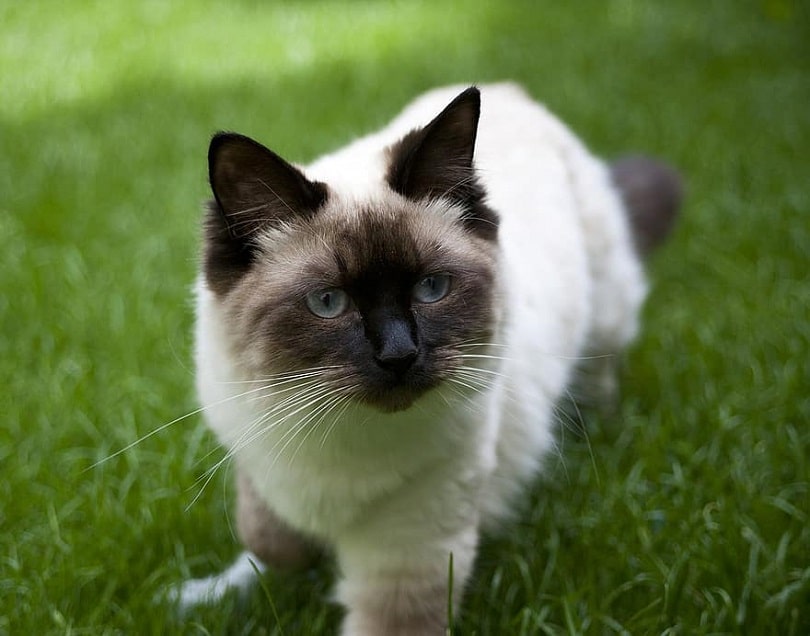
Temperament & Intelligence of the Seal Point Ragdoll
Ragdolls are best known for their tendency to “flop” when you pick them up – hence their name. They generally become dead weight when held, though some bloodlines have this tendency more than others.
Ragdolls are very loveable and attached to their people. They love their people – and all people in general. It is not unusual for Ragdolls to follow their people around the house or greet them at the door. They are considered relatively “dog-like” because of this. They can even learn basic tricks and will retrieve toys that are thrown for them.
They are quite docile. They are not too inactive, however. They tend to enter family activities and do enjoy playtime. However, they are not the most active cats out there and like to cuddle as well.
They are not excessively vocal, but they will remind you when it is mealtime.
Generally, these cats are pretty well behaved indoors. They are easy animals to live with and do not cause very much fuss. They don’t tend to climb very much, though they do have the ability when they need to.
Are These Cats Good for Families?
Yes. These cats are loveable with just about everyone, which makes them perfect for families. They aren’t super playful, but they will provide you with plenty of cuddles. For this reason, they are suitable for a variety of ages. Typically, they are very good with children.
Does This Breed Get Along with Other Pets?
These cats are quite friendly towards other cats, dogs, and even small animals. Of course, like cats, they should not be left alone with small rabbits, mice, or other smaller pets. They are quite large and can do some damage when their hunting instincts kick in.
Things to Know When Owning a Seal Point Ragdoll
Food & Diet Requirements 
These cats have the same dietary requirements as any other feline. They do not have any specific health problems or other issues that require a special diet. Some cats may need a specific diet when they are diagnosed with a health problem, but this is not species-wide.
Any high-quality cat food is a good choice.
Exercise
These cats do not need very much exercise. A short bout of playtime in the afternoon is all they need. Typically, they are pretty good at getting the activity they need, so they do not usually need their humans to encourage movement.
They are more active when they are younger and tend to calm down as they age.
If a cat struggles with obesity, they may need their exercise increased. Otherwise, you can play with your cat when they seem in the mood.
Training
They can be trained with positive reinforcement like praise and food rewards. Some cats love toys, and they can be trained with them as well. As smart cats, they pick up commands pretty quickly. This helps teach them commands like “sit” and behaviors such as using the litterbox.
Grooming ✂️
Ragdolls have long, luxurious coats. They are thick and very soft. However, they also require a bit of maintenance. Luckily, Ragdolls do a pretty good job of keeping their coat clean and tangle-free themselves. However, they do require a bit of regular grooming, to be sure.
You should brush your cat at least twice a week. If you start when they are young, many cats will enjoy their grooming sessions quite a bit. You may find yourself grooming them more than twice a week for a reason.
Brushing ensures that mats do not develop and helps remove twigs and other debris. Bathing is not usually necessary as long as you keep up with your brushing routine.
When brushing, you should first use a stainless-steel comb. Focus particularly on the area where the legs meet the body, as this is where mats are more likely to develop. A rubber curry brush can help smooth the coat when you are done and is a great way to remove dead hair.
Their ears may need to be cleaned with a damp cotton ball every few weeks. Just watch for dirt build-up. If they look dirty, wash them. You should wash their eyes for dirt as well. Teeth health is essential, as well. Brushing a cat’s teeth goes a long way to keeping them healthy.
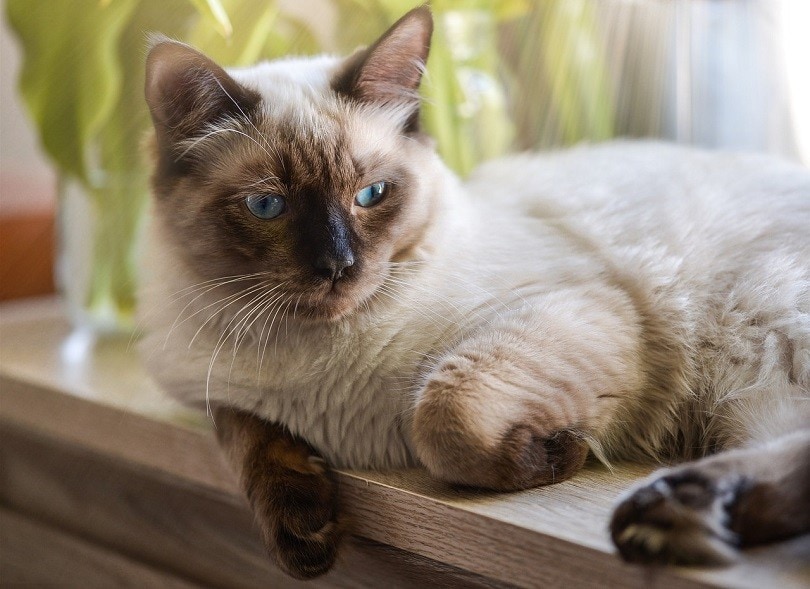
Health and Conditions
These cats are prone to a few different health problems. Their coloration does not seem to play a role in their health. Instead, all Ragdoll colorations are prone to the same health problems.
The parents’ health is going to be more important than the color or appearance of the cat.
Hypertrophic Cardiomyopathy
This is a genetic condition that affects some Ragdolls. It is vital to get your cat from a breeder that does health testing. Otherwise, you can’t be sure if your kitten’s parents are free from these genetic problems.
Hypertrophic Cardiomyopathy is a heart condition where the muscular walls of the heart thicken. This decreases the efficiency of the heart and makes it work harder.
Many cats with this condition do not appear to be ill. When they become severe, cats will show signs of congested heart failure. HCM is significantly dangerous when blood clots are involved, as these can travel to different parts of the body and create all sorts of problems.
Echocardiography is used to diagnose this condition. It is usually well-tolerated by cats, non-invasive, and very useful.
There is no current cure for this condition. However, medication can be used to manage it. The prognosis depends on the severity of the condition. Some cats live for years after being diagnosed. However, this is a progressive disease, so it tends to get worse over time.
Oxalate Bladder Stones
All cats are quite prone to oxalate bladder stones. However, Ragdolls tend to be particularly prone to this issue.
The exact cause of this disease is unknown. Some breeds are predisposed to them, so there does seem to be some genetics at play. However, the extent that genetics plays a role varies. A more acidic diet and higher blood calcium levels are also associated with a higher risk for this disease.
Bladder stones usually become apparent with lots of inflammation and irritation of the bladder wall. Symptoms are usually similar to urinary tract infections or other inflammatory bladder diseases.
Usually, these stones require surgical removal. This surgery requires general anesthesia. Generally, cats will be uncomfortable and need pain medication after surgery. Activity restrictions are usually required.
To prevent them from reoccurring, medication may be necessary. Management may include a prescription diet that is low in calcium. Regular visits to the vet are required to monitor your cat for other stones. Increasing your cat’s water intake is also essential.
Feline Infectious Peritonitis
Ragdolls seem to be particularly prone to FIP. This is a viral infection that mostly affects younger cats, though older cats can be affected.
Unfortunately, diagnosing FIP is very difficult. The virus is known the mutate rapidly, which makes developing a test for it nearly impossible. Some cats develop FIP after contracting a coronavirus. However, others do not. We do not know why some cats are affected, and others are not.
FIP is more prominent in certain breeds, including the Ragdoll. It also seems to be more common in multi-cat households and cats who have recently had surgery. Because it is more common in certain breeds, genetics likely play a role.
Symptoms of FIP include lethargy, decreased appetite, weight loss, and a fever. Eventually, fluid will develop in the body cavities, leading to a swollen abdomen and difficulty breathing. Some cats never develop this increase in fluid, however. These cats will have inflammation in their organs instead, which can lead to various problems.
Sadly, FIP is fatal in almost all cases. Medications can be used to improve the animal’s quality of life for a short time. However, euthanasia may be more humane in most situations.
Male vs. Female
The male Seal Point Ragdoll tends to weigh a little more than the female, reaching the max 20-pound size. Neither cat shows a difference in temperament between genders.
Spaying or neutering your cat is probably the main factor of influence between males and females. If you leave your male unneutered, he’ll be prone to territorial behavior and spraying. Unspayed females will go into heat, which may lead to a runaway situation. Spay or and neuter your Seal Point Ragdoll to prevent unwanted behavioral issues, resulting in a generally happier cat.
Final Thoughts
A Ragdoll is well known for its loving nature and beautiful coat. They are absolutely adorable and very beloved by many cat owners. While they can be a bit more expensive than most cats, many people consider their temperament to be worth the extra cost.
The seal point Ragdoll is not a completely separate breed – just a different coloration. For this reason, they act and look generally like every other Ragdoll out there.
Featured Image Credit: Linn Currie, Shutterstock

